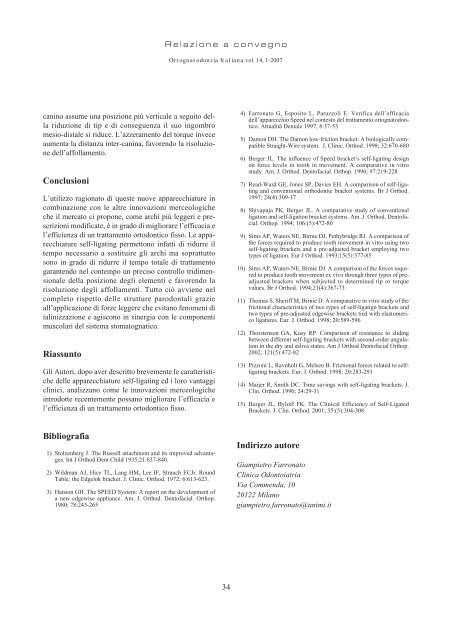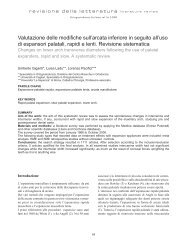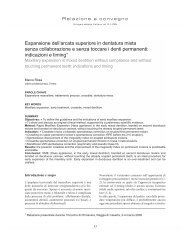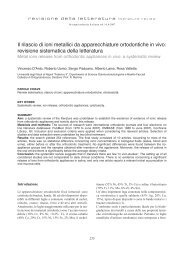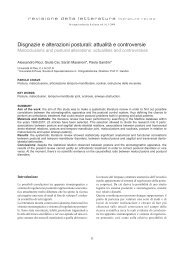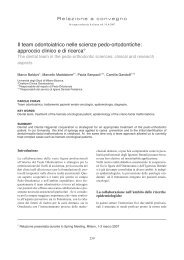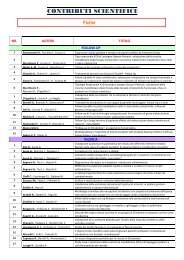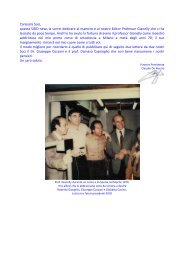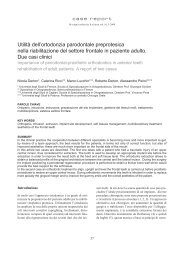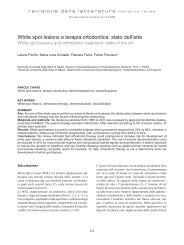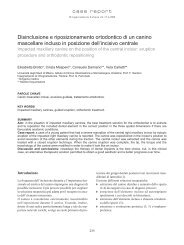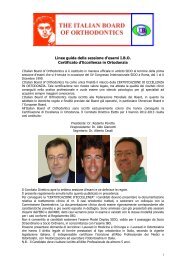Esperienze cliniche con apparecchiature self-ligating: quale futuro?°
Esperienze cliniche con apparecchiature self-ligating: quale futuro?°
Esperienze cliniche con apparecchiature self-ligating: quale futuro?°
You also want an ePaper? Increase the reach of your titles
YUMPU automatically turns print PDFs into web optimized ePapers that Google loves.
canino assume una posizione più verticale a seguito della<br />
riduzione di tip e di <strong>con</strong>seguenza il suo ingombro<br />
mesio-distale si riduce. L’azzeramento del torque invece<br />
aumenta la distanza inter-canina, favorendo la risoluzione<br />
dell’affollamento.<br />
Conclusioni<br />
L’utilizzo ragionato di queste nuove <strong>apparecchiature</strong> in<br />
combinazione <strong>con</strong> le altre innovazioni merceologiche<br />
che il mercato ci propone, come archi più leggeri e prescrizioni<br />
modificate, è in grado di migliorare l’efficacia e<br />
l’efficienza di un trattamento ortodontico fisso. Le <strong>apparecchiature</strong><br />
<strong>self</strong>-<strong>ligating</strong> permettono infatti di ridurre il<br />
tempo necessario a sostituire gli archi ma soprattutto<br />
sono in grado di ridurre il tempo totale di trattamento<br />
garantendo nel <strong>con</strong>tempo un preciso <strong>con</strong>trollo tridimensionale<br />
della posizione degli elementi e favorendo la<br />
risoluzione degli affollamenti. Tutto ciò avviene nel<br />
completo rispetto delle strutture parodontali grazie<br />
all’applicazione di forze leggere che evitano fenomeni di<br />
ialinizzazione e agis<strong>con</strong>o in sinergia <strong>con</strong> le componenti<br />
muscolari del sistema stomatognatico.<br />
Riassunto<br />
Gli Autori, dopo aver descritto brevemente le caratteristiche<br />
delle <strong>apparecchiature</strong> <strong>self</strong>-<strong>ligating</strong> ed i loro vantaggi<br />
clinici, analizzano come le innovazioni merceologiche<br />
introdotte recentemente possano migliorare l’efficacia e<br />
l’efficienza di un trattamento ortodontico fisso.<br />
Bibliografia<br />
1) Stolzenberg J. The Russell attachment and its improved advantages.<br />
Int J Orthod Dent Child 1935;21:837-840.<br />
2) Wildman AJ, Hice TL, Lang HM, Lee IF, Strauch ECJr. Round<br />
Table: the Edgelok bracket. J. Clinic. Orthod. 1972; 6:613-623.<br />
3) Hanson GH. The SPEED System: A report on the development of<br />
a new edgewise appliance. Am. J. Orthod. Dentofacial. Orthop.<br />
1980; 78:243-265<br />
Relazione a <strong>con</strong>vegno<br />
Ortognatodonzia Italiana vol. 14, 1-2007<br />
34<br />
4) Farronato G, Esposito L, Parazzoli E. Verifica dell’efficacia<br />
dell’apparecchio Speed nel <strong>con</strong>testo del trattamento ortognatodontico.<br />
Attualità Dentale 1997; 8:37-53<br />
5) Damon DH. The Damon low-friction bracket: A biologically compatible<br />
Straight-Wire system. J. Clinic. Orthod. 1998; 32:670-680<br />
6) Berger JL. The influence of Speed bracket’s <strong>self</strong>-<strong>ligating</strong> design<br />
on force levels in tooth in movement. A comparative in vitro<br />
study. Am. J. Orthod. Dentofacial. Orthop. 1990; 97:219-228<br />
7) Read-Ward GE, Jones SP, Davies EH. A comparison of <strong>self</strong>-<strong>ligating</strong><br />
and <strong>con</strong>ventional orthodontic bracket systems. Br J Orthod.<br />
1997; 24(4):309-17<br />
8) Shivapuja PK, Berger JL. A comparative study of <strong>con</strong>ventional<br />
ligation and <strong>self</strong>-ligation bracket systems. Am. J. Orthod. Dentofacial.<br />
Orthop. 1994; 106:(5):472-80<br />
9) Sims AP, Waters NE, Birnie DJ, Pethybridge RJ. A comparison of<br />
the forces required to produce tooth movement in vitro using two<br />
<strong>self</strong>-<strong>ligating</strong> brackets and a pre-adjusted bracket employing two<br />
types of ligation. Eur J Orthod. 1993;15(5):377-85<br />
10) Sims AP, Waters NE, Birnie DJ. A comparison of the forces required<br />
to produce tooth movement ex vivo through three types of preadjusted<br />
brackets when subjected to determined tip or torque<br />
values. Br J Orthod. 1994;21(4):367-73<br />
11) Thomas S, Sheriff M, Birnie D. A comparative in vitro study of the<br />
frictional characteristics of two types of <strong>self</strong>-ligatign brackets and<br />
two types of pre-adjusted edgewise brackets tied with elastomerico<br />
ligatures. Eur. J. Orthod. 1998; 20:589-596<br />
12) Thorstenson GA, Kusy RP. Comparison of resistance to sliding<br />
between different <strong>self</strong>-<strong>ligating</strong> brackets with se<strong>con</strong>d-order angulation<br />
in the dry and saliva states. Am J Orthod Dentofacial Orthop.<br />
2002; 121(5):472-82<br />
13) Pizzoni L, Ravnholt G, Melsen B. Frictional forces related to <strong>self</strong><strong>ligating</strong><br />
brackets. Eur. J. Orthod. 1998; 20:283-291<br />
14) Maijer R, Smith DC. Time savings with <strong>self</strong>-<strong>ligating</strong> brackets. J.<br />
Clin. Orthod. 1990; 24:29-31<br />
15) Berger JL, Byloff FK. The Clinical Efficiency of Self-Ligated<br />
Brackets. J. Clin. Orthod. 2001; 35:(5):304-308<br />
Indirizzo autore<br />
Giampietro Farronato<br />
Clinica Odontoiatria<br />
Via Commenda, 10<br />
20122 Milano<br />
giampietro.farronato@unimi.it


